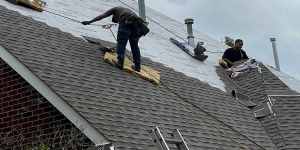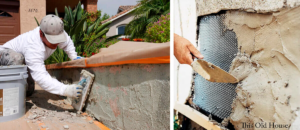Roofing is the silent guardian of a home, protecting its inhabitants from the elements. But it is also an evolving entity, undergoing constant changes as new materials are tested.
Learn about the different varieties of roofing and how they differ from each other. Also, discover tips on hiring a roofing contractor for simple repairs or major re-roofing projects. Click here to Learn More.

The roof is an essential part of a building, protecting it from weather and other environmental factors. The design of a roof encompasses a range of elements, from the type of roofing material to its structure. From the gently sloping shingles of a charming cottage to the dramatic pitched copper roofs gracing European cathedrals, every roofing system has its own unique design.
A few popular roofing designs that have stood the test of time include gable roofs, hipped roofs, and barrel vaulted ceilings. Each has its own distinct characteristics and benefits.
For example, gable roofs have a classic, clean-lined look that complements many home styles. Their simple construction makes them easy to maintain. They are also quite effective at shedding snow and rain, which is an advantage in colder climates. Gable roofs are available in a number of styles, including open gable roofs and box gable roofs.
A hipped roof has a more complex construction than a gable roof, but it is still relatively easy to maintain and can withstand wind and rain very well. They are a common choice for homes in many different styles, from traditional Cape Cod houses to sprawling ranch-style homes.
The slope of a roof is often determined by its height, but it can also be adjusted to suit the homeowner’s preference and the architectural style of the house. For example, a steep slope may be used to create a loft space, while a shallow slope is ideal for a sunroom or playroom.
Many roofing systems use underlayment, a waterproof material that goes underneath the sheathing to protect it from moisture damage. Some underlayment is made of felt, while others are made of synthetic materials like rubber or polycarbonate. Flashing is also a common element of a roof, providing sealant at points where the roof changes direction.
Other important elements of a roof’s design include soffits, ridges, and valleys. The eaves are the edges of the roof that meet the walls, while the ridge is the point where two sloping sides of the roof meet at the top. The soffits are the openings in the eaves that allow air to flow freely.
Materials
Roofing materials are the outer protective layer of a building’s structure, shielding it from harsh weather conditions and other environmental factors. There are many different types of roofing material that can be used on a building, ranging from natural products like thatch to commercially manufactured materials such as tiles and polycarbonate sheeting. When choosing the right roof materials, it is important to consider a variety of factors, such as appearance, cost, and durability.
Thatch is a popular roofing material that can be made from a variety of plant stalks in overlapping layers. It is an affordable option that provides good protection, but it does not last as long as other roofing materials. It is also not recommended for cold climates as it can become brittle and break under the stress of extreme temperatures.
Slate is a beautiful and durable roofing material that adds a unique aesthetic to a home’s exterior. It is expensive, however, and requires specialized installation and maintenance.
Concrete tile roofs are a popular roofing material for Mediterranean and Spanish-style homes. They are durable, fire-resistant, and available in a wide range of colors. They are also fairly easy to maintain and can last for over 50 years.
Built-up roofs (BUR) are an older type of roofing that was popular before membrane roofing became more common. It consists of multiple plies of bitumen-coated organic felts or polyester felts. The plies are laminated together with hot asphalt, coal tar, or cold-applied adhesive. BUR is durable and water-resistant, but it can be susceptible to leaks if the seams are not properly sealed.
Rubber roofing is a relatively new roofing material that combines the benefits of both asphalt and shingles. It is lightweight, resistant to ultraviolet rays, and available in a variety of colors. It is also an environmentally friendly option, as it can be made from recycled materials.
Metal roofing is another durable and attractive option that can withstand severe weather conditions. It is available in a variety of styles, from standing seam metal to galvanized steel and an aluminum-zinc alloy called Galvalume. Metal is also available in a range of colors, so it can be easily blended with other roofing materials to create a cohesive look.
Installation
The roof is the tangible outer shield that protects a building, but it’s also a complex system of materials and components that must be installed, maintained, and repaired properly. Learn more about this essential feature of every home in our extensive guide to roofing, including its many varieties, standard warranty offerings, and maintenance tips.
Start by examining your roof, checking for leaks and any other issues that require attention. You’ll want to be sure you have the right safety gear before starting work, such as rubber-soled shoes or boots, protective eyewear, and a hard hat. It’s also a good idea to have a partner working with you, especially when removing old shingles or installing underlayment or vapor retarder.
Next, carefully remove any shingle strips or pieces that are in poor condition and replace damaged flashing. This is particularly important around chimneys, vents, and valleys, where water tends to collect. Once all of the metal is removed, be sure to trash any nails left behind. You may be able to reuse some of the flashing, but you’ll want to make sure all new metal is fully waterproofed and sealed before installing any shingles or other coverings. Also be sure to thoroughly inspect and remove any old caulking or sealant around penetrations, as this can cause leaks.
Maintenance
A building’s roof acts as its shield from the elements, protecting the interior structures and preserving the integrity of the structure. Like any other system, a roof requires regular maintenance to keep it in good condition and extend its lifespan. It is important to inspect the roof regularly to identify small problems that can escalate into major issues if left untreated.
Debris removal
Regularly removing debris like leaves, twigs, and gravel will help prevent the accumulation of moisture on the roof. Standing water can damage the shingles and promote the growth of algae or mold. It is also important to clear the drains of any clogs or blockages.
Roof maintenance inspections should be conducted by trained roofing professionals on a routine basis, preferably on a biannual basis (once in the spring and once in the fall). Regular inspections will ensure that any minor damage or wear and tear is addressed promptly before it has a chance to worsen.
During a roof inspection, a professional should check the following:
Missing or damaged shingles Loose shingles may indicate water leaks. Missing shingles require immediate replacement to avoid further damage and structural failure. Granule loss Loose granules expose the asphalt layer and accelerate shingle deterioration. Clogged gutters and downspouts
Water-damaged fascia boards
Ponding water
Leaks in the attic
Cracks and holes
Damaged vents
Missing or loose caulking
Damage to the underlayment
Leaking ridge cap
A roof’s flashing is an essential component that prevents water from leaking into a building. Flashing around chimneys, vent pipes, skylights, exhaust fans, and air conditioning units should be inspected on a regular basis. If the flashing is showing signs of deterioration, such as openings, gaps, or crazing, it should be repaired immediately.
It is also a good idea to trim tree branches near the roof on a regular basis. Long branches have the potential to scrape or break shingles during heavy storms. Regular trimming also allows sunlight to reach the roof surface, which helps to prevent the growth of moss or other unwanted vegetation.
